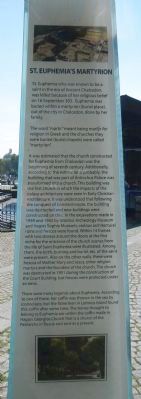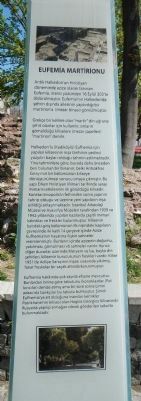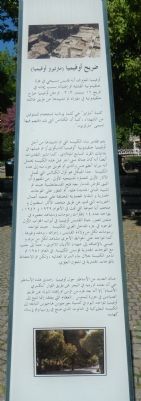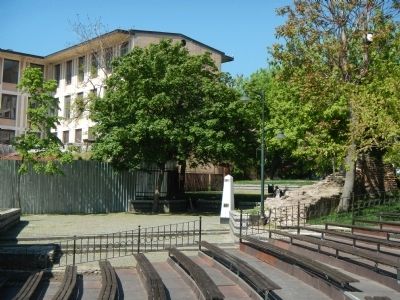Binbirdirek in İstanbul in Fatih, Turkey — West Asia or Southeast Europe
St. Euphemia's Martyrion
Eufemia Martirionu
St. Euphemia who was known to be a saint in the era of Ancient Chalcedon, was killed because of her religious belief on 16 September 303. Euphemia was buried within a martyrion (burial place), out of the city in Chalcedon, done by her family.
The word "martir" meant being martyr for religion in Greek and the churches they were buried in (burial chapels) were called "martyrion".
It was estimated that the church constructed for Euphemia from Chalcedon was the beginning of seventh century. Additionally, according to the estimations, probably, the building that was part of Antiochus Palace was transformed into a church. This building was the first church in which the impacts of the palace architecture were seen in Early Christian Architecture. It was understood that following the conquest of Constantinople, the building was destructed and new buildings were constructed on this. In the excavations made in 1939 and 1942 by Istanbul Archeology Museum and Hagias Sophia Museum, various architectural ruins and frescos were found. Within 14 frames with two stories around the doors at the first niche for the entrance of the church scenes from the life of Saint Euphemia were illustrated. Among them, the birth, burning, and burial, etc. of the saint were present. Also on the other walls, there were frescos of Mother Mary and Jesus, other religion martyrs and the founders of the church. The church was destructed in 1951 during the construction of the Court Building, but the frescos were protected under an eave.
There were many legends about Euphemia. According to one of these, her coffin was thrown in the sea by iconoclasts, but the fishermen in Lemnos Island found this coffin after some time. The bones through to belong to Euphemia are with the coffin made in Hagios Georgios Church that is a church of the Patriarchy in Russia and sent as a present.
Turkish:
Antik Halkedon'un Hıristiyan doneminde azize olarak tanınan Eufemia, inancı yüzünden 16 Eylül 303'te öldürülmüştür. Eufemian'ın Halkedon'da şehrin dışında ailesinin yaptırdığı bir martirion'a (mezar binası) gömülmüştür.
Grekçe bir kelime olan "martir"din uğruna şehit olanlar için kullanılır, onların gömüldüğü kiliselere (mezar şapelleri) "martirion"denilir.
Halkedon'lu (Kadıköylü) Eufhemia için yapılan kilisesinin inşa tarihinin yedinci yüzyılın başları olduğu tahmin edilmektedir. Yine tahminlere göre, burada daha önceden beri bulunan bir binanın, belki Antiokhos Sarayı'nın bir bölümünün kiliseye dönüştürülmesi sonucu ortaya çıkmıştır. Bu yapı Erken Hıristiyan Mimari tarihinde saray mimarisi etkilerinin ilk görüldüğü kilisedir. Konstantinopolis'in fethinden sonra yapının tahrip olduğu ve üzerine yeni yapıların inşa edildiği anlaşılmaktadır. İstanbul Arkeoloji Müzesi ve Ayasofya Müzeleri tarafından 1939 ve 1942 yıllarında yapılan kazılarda çeşitli mimari kalıntılar ve freskler bulunmuştur. Kilisenin batıdaki giriş bölümünün ilk nişindeki kapıların çevresinde iki katlı 14 çerçeve içinde Azize Eufhemia'nın hayatına ilişkin sahneler resimlenmiştir. Bunların içinde azizenin doğumu, yakılması, gömülmesi vb sahneler vardır. Ayrıca diğer duvarlar üzerinde Meryem ve İsa, başka din şehitleri, kilisenin kurucusunun freskleri vardır, Kilise 1951'de Adliye Sarayınin inşası sırasında yıkılmış, fakat freskolar bir saçak altında korunmuştur.
Eufhemia hakkında çok sayıda efsane mevcuttur. Bunlardan birine göre tabutunu ikonoklastlar (Put kırıcılar) denize atmış ama bir süre sonra Limni adasında balıkçılar bu tabutu bulmuştur. Şimdi Eufhemia'ya ait olduğuna inanılan kemikler Patrikhane'nin kilisesi olan Hagios Georgios Kilisesınde Rusya'da yapılıp armağan olarak gönderilen tabutta bulunmaktadır.
Arabic: To read the Arabic text, click on the Arabic image to enlarge it.
Erected by Istanbul Büyükşehir Belediyesi (Istanbul Metropolitan Municipality).
Topics. This historical marker is listed in this topic list: Churches & Religion. A significant historical date for this entry is September 16, 1939.
Location. 41° 0.46′ N, 28° 58.521′ E. Marker is in İstanbul, in Fatih. It is in Binbirdirek. Marker can be reached from Divan Yolu Caddesi, on the right when traveling east. Touch for map. Marker is at or near this postal address: Divan Yolu Cd 9, İstanbul 34122, Turkey. Touch for directions.
Other nearby markers. At least 8 other markers are within walking distance of this marker. Cistern of Philoxenos (within shouting distance of this marker); Firuz Aga Mosque (about 90 meters away, measured in a direct line); German Fountain (about 120 meters away); Serpent Column (about 180 meters away); Mausoleum of Sultan Ahmed I (about 180 meters away); Obelisk of Theodosius (about 210 meters away); Walled Obelisk (about 210 meters away); Basilica Cistern (about 240 meters away). Touch for a list and map of all markers in İstanbul.
More about this marker. This marker is located in Mehmet Akif Ersoy Park near the amphitheater.
Credits. This page was last revised on February 13, 2023. It was originally submitted on June 24, 2015, by Barry Swackhamer of Brentwood, California. This page has been viewed 533 times since then and 49 times this year. Photos: 1, 2, 3, 4. submitted on June 24, 2015, by Barry Swackhamer of Brentwood, California. • Andrew Ruppenstein was the editor who published this page.



